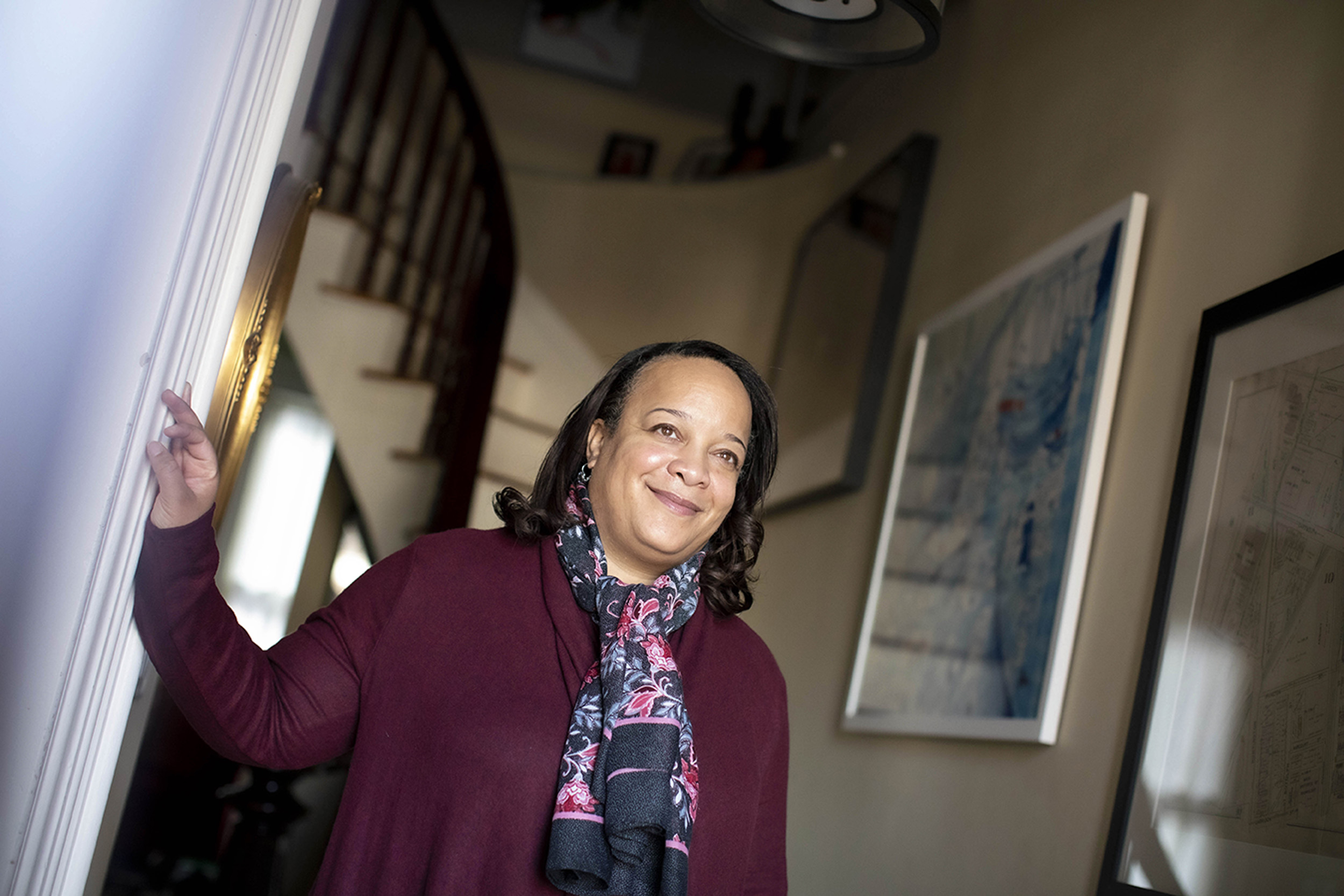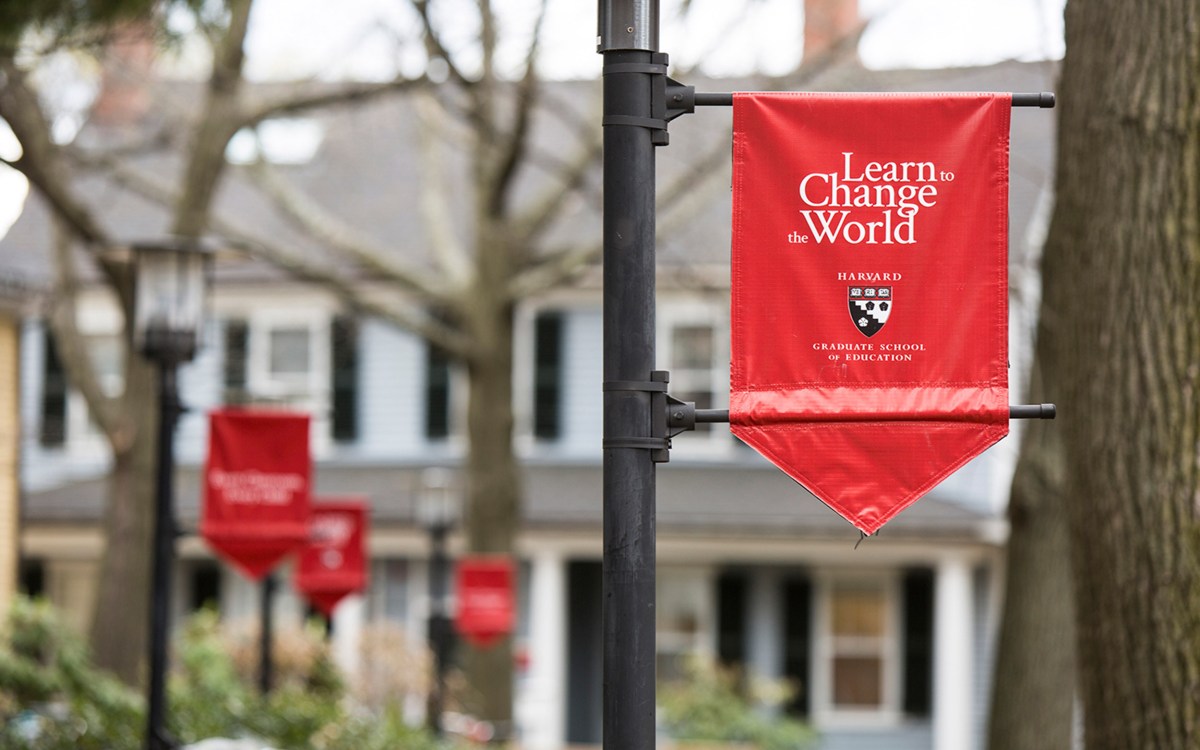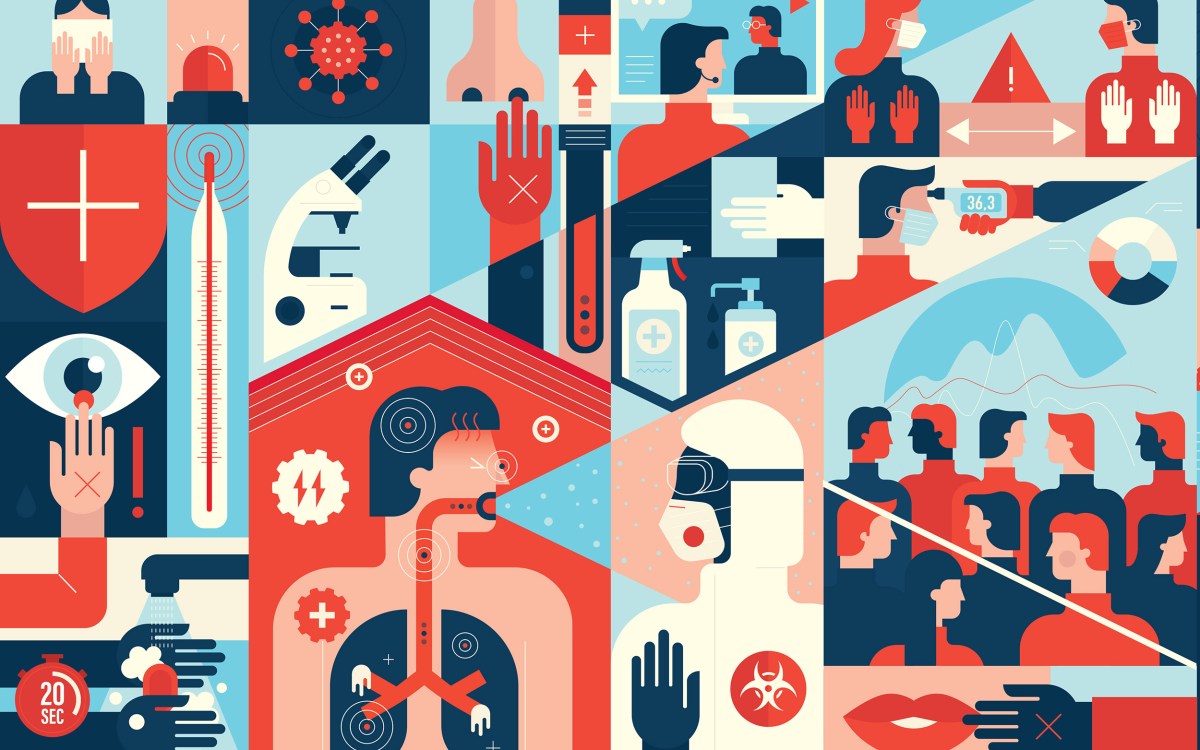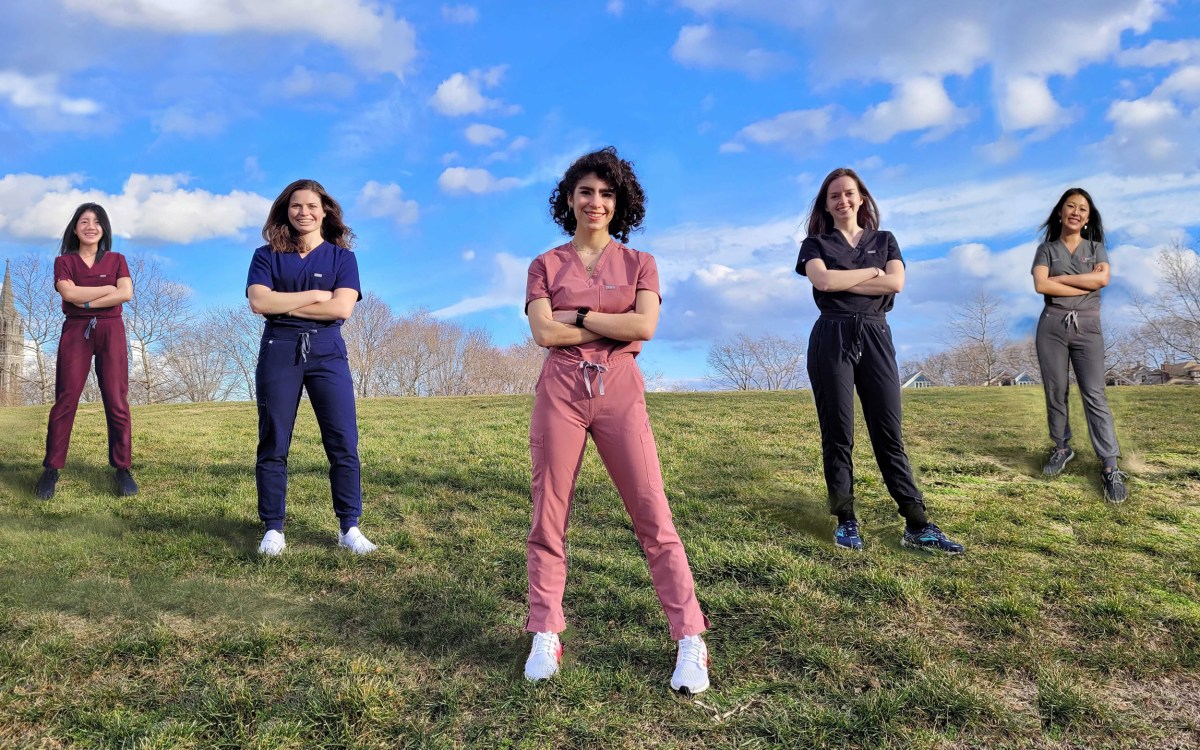
Bridget Long, dean of the Harvard Graduate School of Education, addresses the impact of the COVID-19 crisis in the field of education.
Rose Lincoln/Harvard Staff Photographer
Post-pandemic challenges for schools
Ed School dean says flexibility, more hours key to avoid learning loss
With the closing of schools, the COVID-19 pandemic has revealed many of the injustices facing schoolchildren across the country, from inadequate internet access to housing instability to food insecurity. The Gazette interviewed Bridget Long, A.M. ’97, Ph.D. ’00, dean of the Harvard Graduate School of Education and Saris Professor of Education and Economics, regarding her views on the impact the public health crisis has had on schools, the lessons learned from the pandemic, and the challenges ahead.
Q&A
Bridget Long
GAZETTE: The pandemic exposed many inequities that already existed in the education landscape. Which ones concern you the most?
LONG: Persistent inequities in education have always been a concern, but with the speed and magnitude of the changes brought on by the pandemic, it underscored several major problems. First of all, we often think about education as being solely an academic enterprise, but our schools really do so much more. Immediately, we saw children and families struggling with basic needs, such as access to food and health care, which our schools provide but all of a sudden were removed. We also shifted our focus, once we had to be in lockdown, to the differences in students’ home environments, whether it was lack of access to technology and the other commitments and demands on their time in terms of family situations, space, basic needs, and so forth. The focus had to shift from leveling the playing field within school or within college to instead what are the differences in inequities inside students’ homes and neighborhoods and the differences in the quality and rigor and supports available to students of different backgrounds. All of this was just exacerbated with the pandemic. There are concerns about learning loss and how that will vary across different income groups, communities, and neighborhoods. But there are also concerns about trauma and the mental health strain of the pandemic and how the strain of racial injustice and political turmoil has also been experienced — no doubt differently by different parts of population. And all of that has impacted students’ well-being and academic performance. The inequities we have long seen have become worse this year.
GAZETTE: Now that those inequities have been exposed, what can leaders in education do to navigate those issues? Are there any specific lessons learned?
LONG: Something that many educators already understood is that one size does not fit all. This is why education is so complex and why it has been so challenging to bring about improvements because there’s no silver bullet. The solution depends on the individual, the community, and the classroom.
At first, the public health crisis underscored that we needed to meet students where they are. This has been a long-held lesson among experienced education professionals, but it became even more important. In many respects, it butted up against some of our systems, which tried to come up with across-the-board approaches when instead what we needed was a bit of nimbleness depending on the context of the particular school or classroom and the individual needs of students.
Where you have seen some success and progress is where principals and teachers have been proactive and creative in how they can meet the needs of their students. What’s underneath all of this, regardless of whether we’re face-to-face or on technology, is the importance of people and personal connections. Education is a labor-intensive industry. Technology can help us in many respects to supplement or complement what we do, but the key has always been individual personal connection. Some teachers have been able to connect with their students, whether by phone or on Zoom, or schools, where they put concerted effort into doing outreach in the community to check on families to make sure they had basic needs. Some schools were able to understand what challenges their students were facing and were somewhat flexible and proactive to address those challenges, especially if they already had strong parental engagement. That’s where you have continued to see progress and growth.
“In many respects, this crisis forced the entire field to rethink our teaching in a way that I don’t know has happened before.”
GAZETTE: You spoke about concerns about learning loss. What can we do to avoid a lost year?
LONG: One of the difficulties is that the experience has differed tremendously. For some students, their parents have been able to supplement or their schools have been able to react. The hope is that they will not lose much learning time, while other students effectively haven’t been in school for almost a year; they have lost quite a bit of ground. As a teacher, you can imagine your students come back to school, and all of a sudden, students of the same chronological age are actually in very different places, depending on their individual family situation and what accommodations were able to be made. I think there’s a great deal we can do to try to address that. First of all, we have to have some understanding of what gains students have made as well as things they haven’t learned yet. That means taking a moment to see where a student is in their learning. The second thing is to make sure we’re capturing the lessons learned from this pandemic by identifying places where teachers and schools used a combination of technology, outreach, personal instruction, and tutors and mentors, and helped students make progress in their learning. We need to share those lessons more broadly so that other districts can see examples that have worked.
As we look ahead, I think it will take extending learning time to close the gaps. Schools will have to decide whether that is after school, weekends, or summer, and whether or not that’s going to involve the teachers themselves, or if it’s going to be using the best tools that are out there, such as videos and technology platforms that students and families use themselves. There has already been talk by some districts of extending the school year into summer or having summer-camp-type programs to give students additional time to work through some of the material.
The other important piece is partnerships. Schools oftentimes work with members of the community or nonprofit organizations, and that’s a really important layer in our system. After-school programs, enrichment programs, tutors, and mentors are essential, and we really want to continue with that expanded sense of capacity and partnership. It’s going to have an impact on all of us if we lose a generation, or if this generation goes backwards in terms of their learning. It certainly is in all of our best interests to try to contribute to the solution.
GAZETTE: Many parents gained renewed appreciation of the work teachers do. Do you think the pandemic would lead to a reappraisal of the profession?
LONG: Certainly, in the beginning, there was so much more appreciation for what teachers do. As parents needed to start doing homeschooling, there was a new understanding of just how difficult teaching is. Imagine having a classroom with different personalities, different strengths and assets, and also different weaknesses, and somehow being nimble enough to continue that class moving forward. As time has gone on, I worry a little bit about the level of contentiousness in some communities as schools haven’t reopened. There is the balancing act between caring for children’s learning and the fact that we have to make sure that the adults are safe and supported. You hear stories of teachers trying to teach from home while they are also homeschooling their own children. I would hope that coming out of this would be an appreciation of the amazing things teachers do in the classroom, as well as also some acknowledgement that these are people who are also living through a devastating pandemic with all the stress and strain that every individual is going through.
One other point is that given that we know that teachers do more than just academics, we need to make sure our teachers are trained to be able to provide social emotional support to students. As some of the students come back into the classroom, we need to acknowledge that they may be dealing with devastating losses, or the frustration of being kept inside, or the violence that is happening in their homes and neighborhoods. It’s very hard to learn if you’re first dealing with those kinds of issues. Our teachers already do so much, and we need to support them more and provide even more training to help them address that wide-ranging set of challenges their students may be facing even before they can get to the learning part.
“Something that many educators already understood is that one size does not fit all. This is why education is so complex and why it has been so challenging to bring about improvements because there’s no silver bullet.”
GAZETTE: Are there any silver linings in education brought on by the pandemic?
LONG: The first one is when we all needed to pivot last spring, and especially this fall, many educators took a moment to pause and reflect on their learning goals and priorities. There was a great deal of discussion, both in K‒12 and higher education, to think carefully and deliberately about the ways in which we could make sure our teaching was engaging and active and how we could bring in different voices and perspectives. In many respects, this crisis forced the entire field to rethink our teaching in a way that I don’t know has happened before. The second silver lining is the innovation and creativity. Because there wasn’t necessarily one right answer, you saw a lot of experimentation. We have seen an explosion of different approaches to teaching, and many more people got involved in that process, not just some small 10 percent of the teaching force. We’ve identified new ways of engaging with our students, and we’ve also increased the capacity of our educators to be able to deliver new ways of engagement. From this process, my hope is that we’ll walk away with even more tools and approaches to how we engage our students, so that we can then make choices about what to do face-to-face, how to use technology, and what to do in more of an asynchronous sort of way. But key to this is being able to share those lessons learned with others, how you were able to still maintain connection, how you were better able to teach certain material, and perhaps even build better relationships with parents and families during this process. Just the innovation, experimentation, and growth of instructors in many places has been very positive in so many respects.
GAZETTE: In which ways do you think the education system should be transformed after this year? How should it be rebuilt?
LONG: First, we’ve all had to understand that education and schools are not a spot on a map. They are actually communities; they have to include families, nonprofit organizations, and community-based organizations. For a university in particular, it’s not just about coming to campus; it’s actually about the people coming together, and how they are involved in learning from each other. It’s great to push on this reconceptualization and to be clear that education is an exchange of information, of perspective, of content, and making connections, regardless of the age of the student. The crisis has also forced us to go back to some of the fundamentals of what do we need students to learn, and how are we going to accomplish those goals. That has been a very important discussion for education. And the third part is realizing that education is not a one-size-fits-all. The best educators use multiple methods and approaches to be able to connect with their students, to be able to present material, and to provide support. That’s always been the case. How do we meet students where they are? That framing is one that I hope will not go away because all students have the potential to learn, and it’s a matter of how to personalize the learning experience to meet their needs, how we notice and provide supports to help learners who are struggling. That really is at the core of education, and I hope that we will take away that lesson as we look ahead.
GAZETTE: What do you think the role of higher education should be in this new educational landscape?
LONG: Higher education has an incredibly important role, and in particular given the economic recession. Traditionally, this is when many more people go into higher education to learn new skills, given what’s happening in the labor market. We have yet to see what the long-term impact is going to be, but in the short term, one thing we’ve noticed is that college enrollments are down. That’s very alarming and may have to do with how suddenly and how quickly the pandemic affected society. The first thing that higher education is going to have to think about is increasing proactive outreach — how to connect with potential students and how to help them get into programs that are going to give them skills necessary for this changing economy. Unfortunately, they’ll be doing this in a context where students are going to have greater needs, and where it’s not quite clear if funding from state and local governments is going to be declining. That’s the challenge that higher education will have to face. While it’s an amazing instrument in helping individuals further their skills or retool their skills, we need to make investments and make sure individuals can actually access the training available in our colleges and universities.
GAZETTE: What are your hopes for the Biden administration in the area of education?
LONG: Government has a very important role in education, but it has to be balanced with the importance of local control and the fact that the context of every community is slightly different. Certainly, as we’ve been in the middle of a public health crisis, this has been incredibly challenging for schools. Schools had been trying to continue providing food and health care and connect with their students and, all of a sudden, they had to become experts in public health and buildings. This is something that falls under the purview of the federal government. Having access to the best doctors, the best public health officials, and people who think about buildings, and how to make things safe, the government needs to put that information together to give guidance to schools, principals, and teachers. It’s the government that can say, “Here are the risks, and here are the things you can do to mitigate those risks. Here are the conditions that are necessary for buildings. Here is what we know in terms of preventing spread, and here is what we know about the impact on children of different ages, and how we can protect the adults.” That kind of guidance would be incredibly helpful, as you have all of these individual school districts trying to sort through complex information and what the science says and how it applies to their particular context. Guidance is No. 1.
No. 2 is data. It’s very important having some understanding about where we stand in terms of learning loss, what we need to prioritize, and what areas of the country perhaps need more help than others. The other key component is to gauge what lessons have been learned and share the best practices across all school districts. The idea is to use the federal government as a central information bank with proactive outreach to schools. Government also plays a critical role in funding the research that will document the lessons from this pandemic.
It’s going to be incredibly helpful to have a more active federal government. As we have a better sense about where our students are the most vulnerable, and what are the kinds of high-impact practices that would be most beneficial, it’s going to be critical having the funding to support those kinds of investments because they will most certainly pay off. That possibility, I’m much more optimistic about now.
This interview has been condensed and edited for length and clarity







